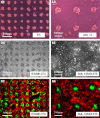Engineering systems for the generation of patterned co-cultures for controlling cell-cell interactions
- PMID: 20655984
- PMCID: PMC3026923
- DOI: 10.1016/j.bbagen.2010.07.002
Engineering systems for the generation of patterned co-cultures for controlling cell-cell interactions
Abstract
Background: Inside the body, cells lie in direct contact or in close proximity to other cell types in a tightly controlled architecture that often regulates the resulting tissue function. Therefore, tissue engineering constructs that aim to reproduce the architecture and the geometry of tissues will benefit from methods of controlling cell-cell interactions with microscale resolution.
Scope of the review: We discuss the use of microfabrication technologies for generating patterned co-cultures. In addition, we categorize patterned co-culture systems by cell type and discuss the implications of regulating cell-cell interactions in the resulting biological function of the tissues.
Major conclusions: Patterned co-cultures are a useful tool for fabricating tissue engineered constructs and for studying cell-cell interactions in vitro, because they can be used to control the degree of homotypic and heterotypic cell-cell contact. In addition, this approach can be manipulated to elucidate important factors involved in cell-matrix interactions.
General significance: Patterned co-culture strategies hold significant potential to develop biomimetic structures for tissue engineering. It is expected that they would create opportunities to develop artificial tissues in the future. This article is part of a Special Issue entitled Nanotechnologies - Emerging Applications in Biomedicine.
2010 Elsevier B.V. All rights reserved.
Figures









Similar articles
-
The use of patterned dual thermoresponsive surfaces for the collective recovery as co-cultured cell sheets.Biomaterials. 2005 May;26(14):1885-93. doi: 10.1016/j.biomaterials.2004.06.005. Biomaterials. 2005. PMID: 15576162
-
Generation of a patterned co-culture system composed of adherent cells and immobilized nonadherent cells.Acta Biomater. 2016 Feb;31:231-240. doi: 10.1016/j.actbio.2015.12.016. Epub 2015 Dec 11. Acta Biomater. 2016. PMID: 26685756
-
Controlling cell interactions by micropatterning in co-cultures: hepatocytes and 3T3 fibroblasts.J Biomed Mater Res. 1997 Feb;34(2):189-99. doi: 10.1002/(sici)1097-4636(199702)34:2<189::aid-jbm8>3.0.co;2-m. J Biomed Mater Res. 1997. PMID: 9029299
-
Biomaterials in co-culture systems: towards optimizing tissue integration and cell signaling within scaffolds.Biomaterials. 2014 May;35(15):4465-76. doi: 10.1016/j.biomaterials.2014.02.023. Epub 2014 Mar 3. Biomaterials. 2014. PMID: 24602569 Review.
-
Nanoscale engineering of extracellular matrix-mimetic bioadhesive surfaces and implants for tissue engineering.Biochim Biophys Acta. 2011 Mar;1810(3):350-60. doi: 10.1016/j.bbagen.2010.04.006. Epub 2010 May 8. Biochim Biophys Acta. 2011. PMID: 20435097 Free PMC article. Review.
Cited by
-
Gelatin-Methacryloyl (GelMA) Formulated with Human Platelet Lysate Supports Mesenchymal Stem Cell Proliferation and Differentiation and Enhances the Hydrogel's Mechanical Properties.Bioengineering (Basel). 2019 Aug 28;6(3):76. doi: 10.3390/bioengineering6030076. Bioengineering (Basel). 2019. PMID: 31466260 Free PMC article.
-
Modeling of human neurulation using bioengineered pluripotent stem cell culture.Curr Opin Biomed Eng. 2020 Mar;13:127-133. doi: 10.1016/j.cobme.2020.02.002. Epub 2020 Feb 17. Curr Opin Biomed Eng. 2020. PMID: 32328535 Free PMC article.
-
Advances of Stem Cell-Laden Hydrogels With Biomimetic Microenvironment for Osteochondral Repair.Front Bioeng Biotechnol. 2020 Mar 31;8:247. doi: 10.3389/fbioe.2020.00247. eCollection 2020. Front Bioeng Biotechnol. 2020. PMID: 32296692 Free PMC article. Review.
-
Recent development of temperature-responsive surfaces and their application for cell sheet engineering.Regen Biomater. 2014 Nov;1(1):91-102. doi: 10.1093/rb/rbu011. Epub 2014 Oct 20. Regen Biomater. 2014. PMID: 26816628 Free PMC article. Review.
-
In vitro models of the cardiac microenvironment to study myocyte and non-myocyte crosstalk: bioinspired approaches beyond the polystyrene dish.J Physiol. 2017 Jun 15;595(12):3891-3905. doi: 10.1113/JP273100. Epub 2017 Feb 27. J Physiol. 2017. PMID: 28116799 Free PMC article. Review.
References
-
- Khetani SR, Bhatia SN. Engineering tissues for in vitro applications. Curr. Opin. Biotechnol. 2006;17:524–531. - PubMed
-
- Bhatia SN, Balis UJ, Yarmush ML, Toner M. Effect of cell-cell interactions in preservation of cellular phenotype: cocultivation of hepatocytes and nonparenchymal cells. FASEB J. 1999;13:1883–1900. - PubMed
-
- Guguenguillouzo C, Clement B, Baffet G, Beaumont C, Morelchany E, Glaise D, Guillouzo A. Maintenance and reversibility of active albumin secretion by adult-rat hepatocytes co-cultured with another liver epithelial-cell type. Exp. Cell Res. 1983;143:47–54. - PubMed
Publication types
MeSH terms
Substances
Grants and funding
LinkOut - more resources
Full Text Sources
Other Literature Sources
Research Materials

